An Analysis of Aircraft Noise on Children's Cognitive Abilities
VerifiedAdded on 2020/07/22
|58
|17820
|445
Dissertation
AI Summary
This dissertation investigates the impact of aircraft noise on the perceived cognitive abilities of 6-7 year old children near Heathrow Airport. The study employs a qualitative research approach, including thematic perception tests and analysis of both primary and secondary sources, to assess the effects of noise on attention, memory, and learning. The research examines the relationship between aircraft noise levels and children's cognitive performance, considering factors such as geographical location of schools and OFSTED reports. The findings suggest that aircraft noise negatively affects children's health and learning, impacting memory recall and overall cognitive function. The dissertation includes a comprehensive literature review, detailed research methodology, data analysis, and recommendations for mitigating the adverse effects of aircraft noise on children's cognitive development. The study aims to provide insights for educators, policymakers, and other stakeholders to develop strategies that promote a better learning environment for children near airports.
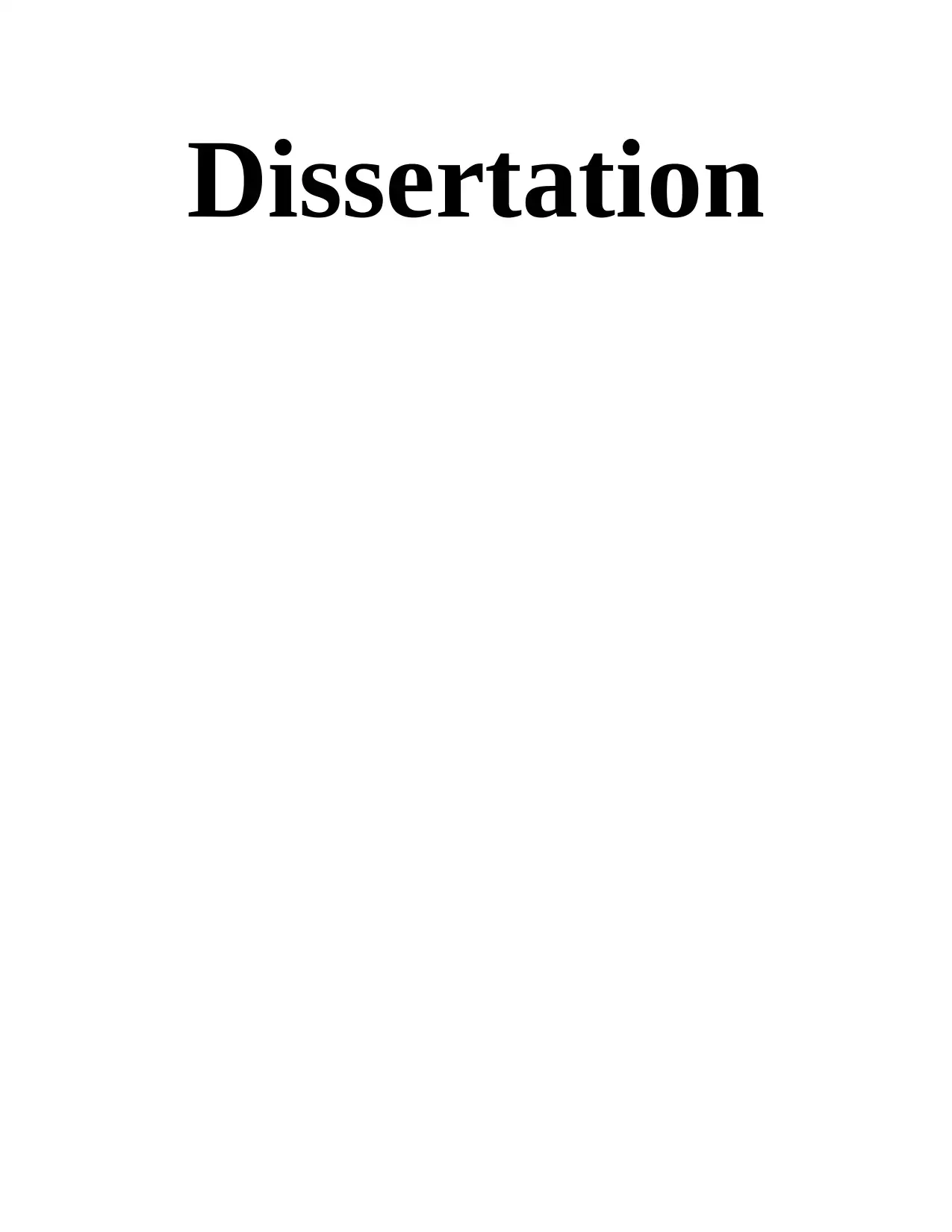
Dissertation
Paraphrase This Document
Need a fresh take? Get an instant paraphrase of this document with our AI Paraphraser
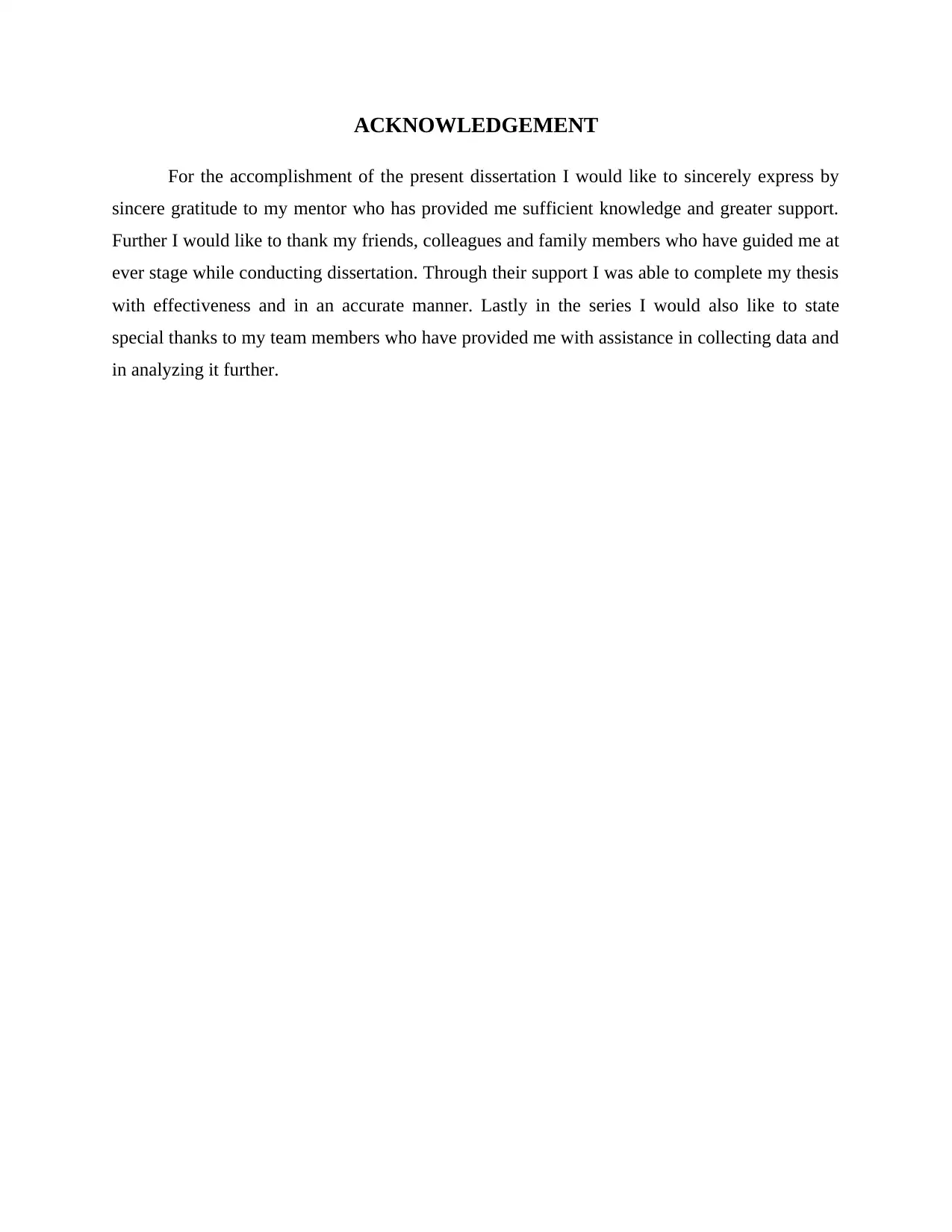
ACKNOWLEDGEMENT
For the accomplishment of the present dissertation I would like to sincerely express by
sincere gratitude to my mentor who has provided me sufficient knowledge and greater support.
Further I would like to thank my friends, colleagues and family members who have guided me at
ever stage while conducting dissertation. Through their support I was able to complete my thesis
with effectiveness and in an accurate manner. Lastly in the series I would also like to state
special thanks to my team members who have provided me with assistance in collecting data and
in analyzing it further.
For the accomplishment of the present dissertation I would like to sincerely express by
sincere gratitude to my mentor who has provided me sufficient knowledge and greater support.
Further I would like to thank my friends, colleagues and family members who have guided me at
ever stage while conducting dissertation. Through their support I was able to complete my thesis
with effectiveness and in an accurate manner. Lastly in the series I would also like to state
special thanks to my team members who have provided me with assistance in collecting data and
in analyzing it further.
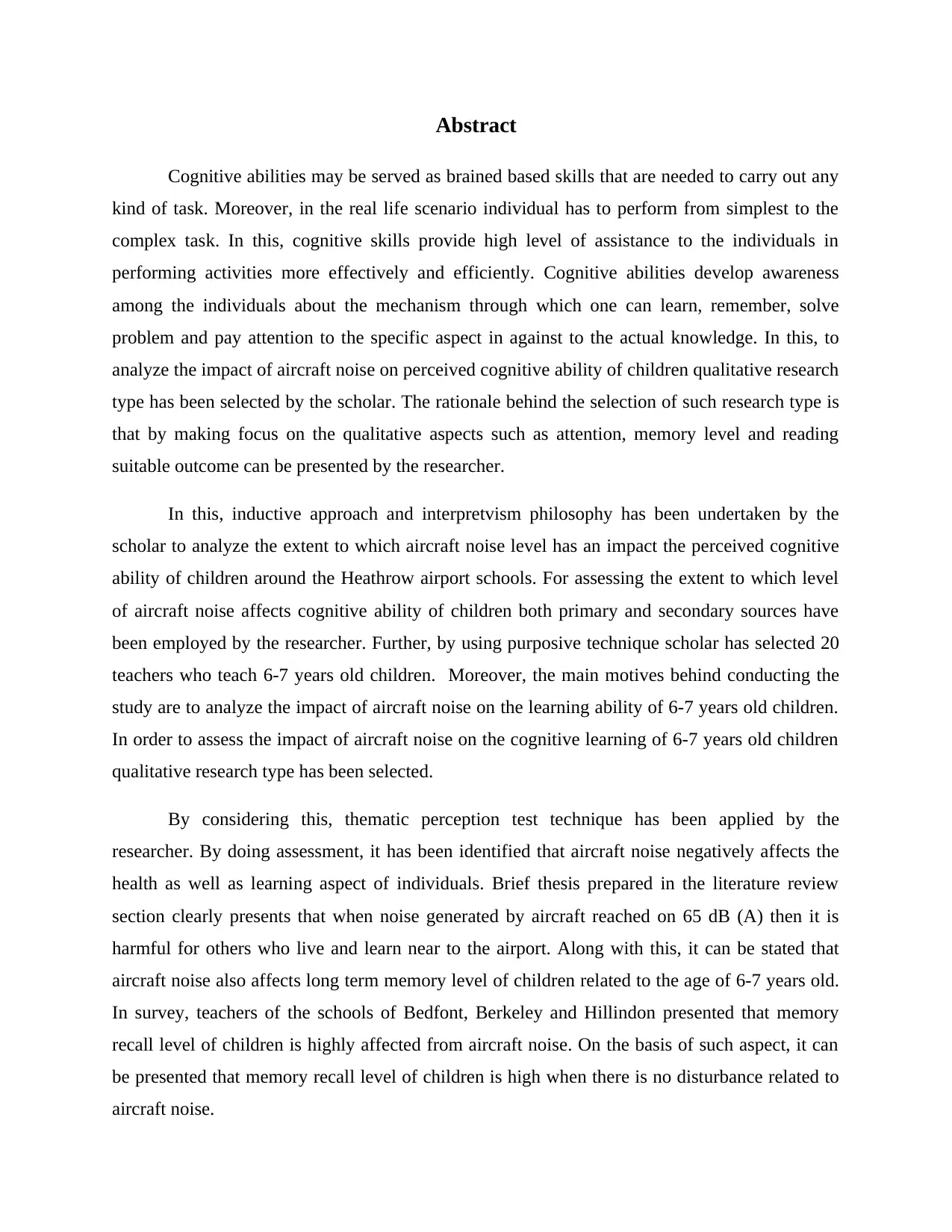
Abstract
Cognitive abilities may be served as brained based skills that are needed to carry out any
kind of task. Moreover, in the real life scenario individual has to perform from simplest to the
complex task. In this, cognitive skills provide high level of assistance to the individuals in
performing activities more effectively and efficiently. Cognitive abilities develop awareness
among the individuals about the mechanism through which one can learn, remember, solve
problem and pay attention to the specific aspect in against to the actual knowledge. In this, to
analyze the impact of aircraft noise on perceived cognitive ability of children qualitative research
type has been selected by the scholar. The rationale behind the selection of such research type is
that by making focus on the qualitative aspects such as attention, memory level and reading
suitable outcome can be presented by the researcher.
In this, inductive approach and interpretvism philosophy has been undertaken by the
scholar to analyze the extent to which aircraft noise level has an impact the perceived cognitive
ability of children around the Heathrow airport schools. For assessing the extent to which level
of aircraft noise affects cognitive ability of children both primary and secondary sources have
been employed by the researcher. Further, by using purposive technique scholar has selected 20
teachers who teach 6-7 years old children. Moreover, the main motives behind conducting the
study are to analyze the impact of aircraft noise on the learning ability of 6-7 years old children.
In order to assess the impact of aircraft noise on the cognitive learning of 6-7 years old children
qualitative research type has been selected.
By considering this, thematic perception test technique has been applied by the
researcher. By doing assessment, it has been identified that aircraft noise negatively affects the
health as well as learning aspect of individuals. Brief thesis prepared in the literature review
section clearly presents that when noise generated by aircraft reached on 65 dB (A) then it is
harmful for others who live and learn near to the airport. Along with this, it can be stated that
aircraft noise also affects long term memory level of children related to the age of 6-7 years old.
In survey, teachers of the schools of Bedfont, Berkeley and Hillindon presented that memory
recall level of children is highly affected from aircraft noise. On the basis of such aspect, it can
be presented that memory recall level of children is high when there is no disturbance related to
aircraft noise.
Cognitive abilities may be served as brained based skills that are needed to carry out any
kind of task. Moreover, in the real life scenario individual has to perform from simplest to the
complex task. In this, cognitive skills provide high level of assistance to the individuals in
performing activities more effectively and efficiently. Cognitive abilities develop awareness
among the individuals about the mechanism through which one can learn, remember, solve
problem and pay attention to the specific aspect in against to the actual knowledge. In this, to
analyze the impact of aircraft noise on perceived cognitive ability of children qualitative research
type has been selected by the scholar. The rationale behind the selection of such research type is
that by making focus on the qualitative aspects such as attention, memory level and reading
suitable outcome can be presented by the researcher.
In this, inductive approach and interpretvism philosophy has been undertaken by the
scholar to analyze the extent to which aircraft noise level has an impact the perceived cognitive
ability of children around the Heathrow airport schools. For assessing the extent to which level
of aircraft noise affects cognitive ability of children both primary and secondary sources have
been employed by the researcher. Further, by using purposive technique scholar has selected 20
teachers who teach 6-7 years old children. Moreover, the main motives behind conducting the
study are to analyze the impact of aircraft noise on the learning ability of 6-7 years old children.
In order to assess the impact of aircraft noise on the cognitive learning of 6-7 years old children
qualitative research type has been selected.
By considering this, thematic perception test technique has been applied by the
researcher. By doing assessment, it has been identified that aircraft noise negatively affects the
health as well as learning aspect of individuals. Brief thesis prepared in the literature review
section clearly presents that when noise generated by aircraft reached on 65 dB (A) then it is
harmful for others who live and learn near to the airport. Along with this, it can be stated that
aircraft noise also affects long term memory level of children related to the age of 6-7 years old.
In survey, teachers of the schools of Bedfont, Berkeley and Hillindon presented that memory
recall level of children is highly affected from aircraft noise. On the basis of such aspect, it can
be presented that memory recall level of children is high when there is no disturbance related to
aircraft noise.
⊘ This is a preview!⊘
Do you want full access?
Subscribe today to unlock all pages.

Trusted by 1+ million students worldwide
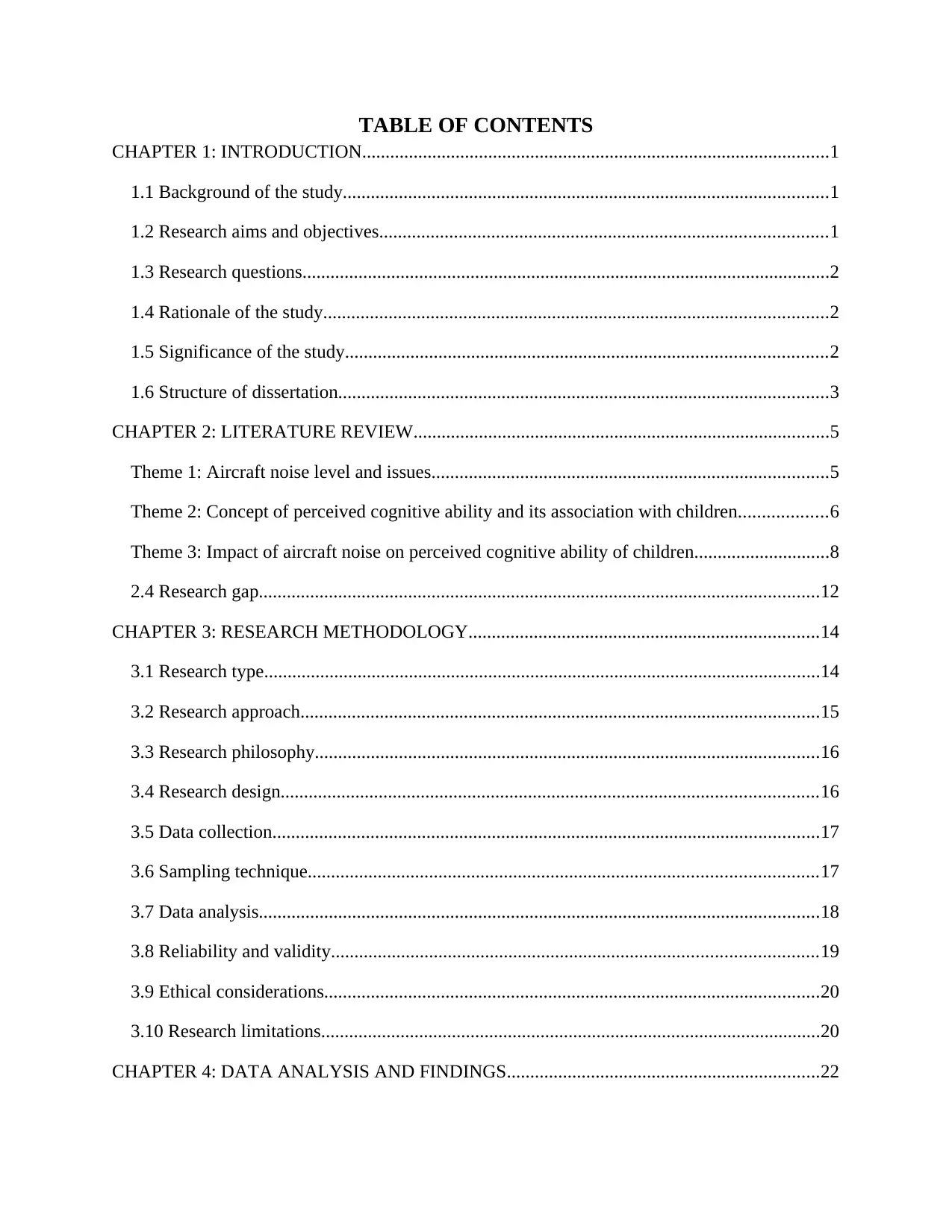
TABLE OF CONTENTS
CHAPTER 1: INTRODUCTION....................................................................................................1
1.1 Background of the study........................................................................................................1
1.2 Research aims and objectives................................................................................................1
1.3 Research questions.................................................................................................................2
1.4 Rationale of the study............................................................................................................2
1.5 Significance of the study.......................................................................................................2
1.6 Structure of dissertation.........................................................................................................3
CHAPTER 2: LITERATURE REVIEW.........................................................................................5
Theme 1: Aircraft noise level and issues.....................................................................................5
Theme 2: Concept of perceived cognitive ability and its association with children...................6
Theme 3: Impact of aircraft noise on perceived cognitive ability of children.............................8
2.4 Research gap........................................................................................................................12
CHAPTER 3: RESEARCH METHODOLOGY...........................................................................14
3.1 Research type.......................................................................................................................14
3.2 Research approach...............................................................................................................15
3.3 Research philosophy............................................................................................................16
3.4 Research design...................................................................................................................16
3.5 Data collection.....................................................................................................................17
3.6 Sampling technique.............................................................................................................17
3.7 Data analysis........................................................................................................................18
3.8 Reliability and validity........................................................................................................19
3.9 Ethical considerations..........................................................................................................20
3.10 Research limitations...........................................................................................................20
CHAPTER 4: DATA ANALYSIS AND FINDINGS...................................................................22
CHAPTER 1: INTRODUCTION....................................................................................................1
1.1 Background of the study........................................................................................................1
1.2 Research aims and objectives................................................................................................1
1.3 Research questions.................................................................................................................2
1.4 Rationale of the study............................................................................................................2
1.5 Significance of the study.......................................................................................................2
1.6 Structure of dissertation.........................................................................................................3
CHAPTER 2: LITERATURE REVIEW.........................................................................................5
Theme 1: Aircraft noise level and issues.....................................................................................5
Theme 2: Concept of perceived cognitive ability and its association with children...................6
Theme 3: Impact of aircraft noise on perceived cognitive ability of children.............................8
2.4 Research gap........................................................................................................................12
CHAPTER 3: RESEARCH METHODOLOGY...........................................................................14
3.1 Research type.......................................................................................................................14
3.2 Research approach...............................................................................................................15
3.3 Research philosophy............................................................................................................16
3.4 Research design...................................................................................................................16
3.5 Data collection.....................................................................................................................17
3.6 Sampling technique.............................................................................................................17
3.7 Data analysis........................................................................................................................18
3.8 Reliability and validity........................................................................................................19
3.9 Ethical considerations..........................................................................................................20
3.10 Research limitations...........................................................................................................20
CHAPTER 4: DATA ANALYSIS AND FINDINGS...................................................................22
Paraphrase This Document
Need a fresh take? Get an instant paraphrase of this document with our AI Paraphraser
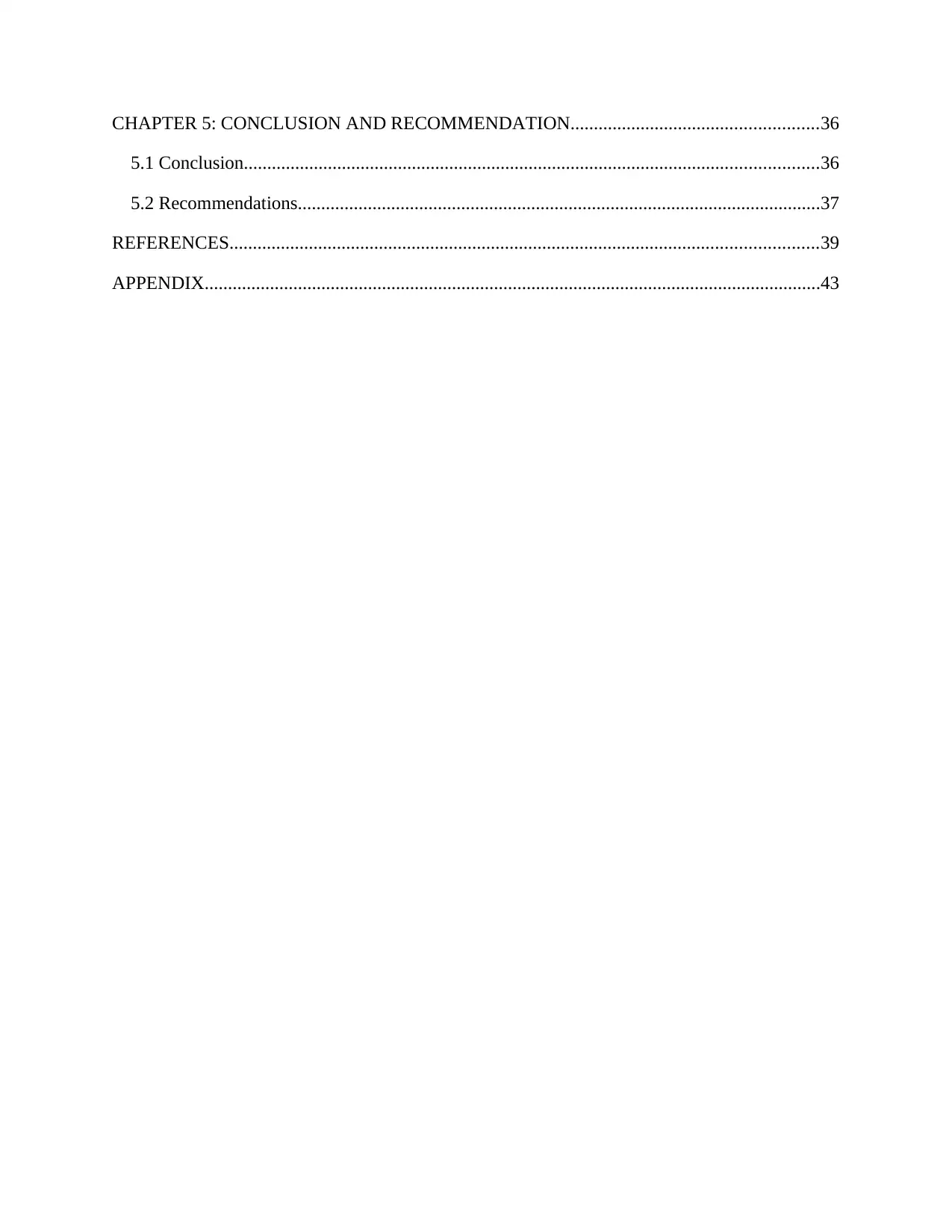
CHAPTER 5: CONCLUSION AND RECOMMENDATION.....................................................36
5.1 Conclusion...........................................................................................................................36
5.2 Recommendations................................................................................................................37
REFERENCES..............................................................................................................................39
APPENDIX....................................................................................................................................43
5.1 Conclusion...........................................................................................................................36
5.2 Recommendations................................................................................................................37
REFERENCES..............................................................................................................................39
APPENDIX....................................................................................................................................43
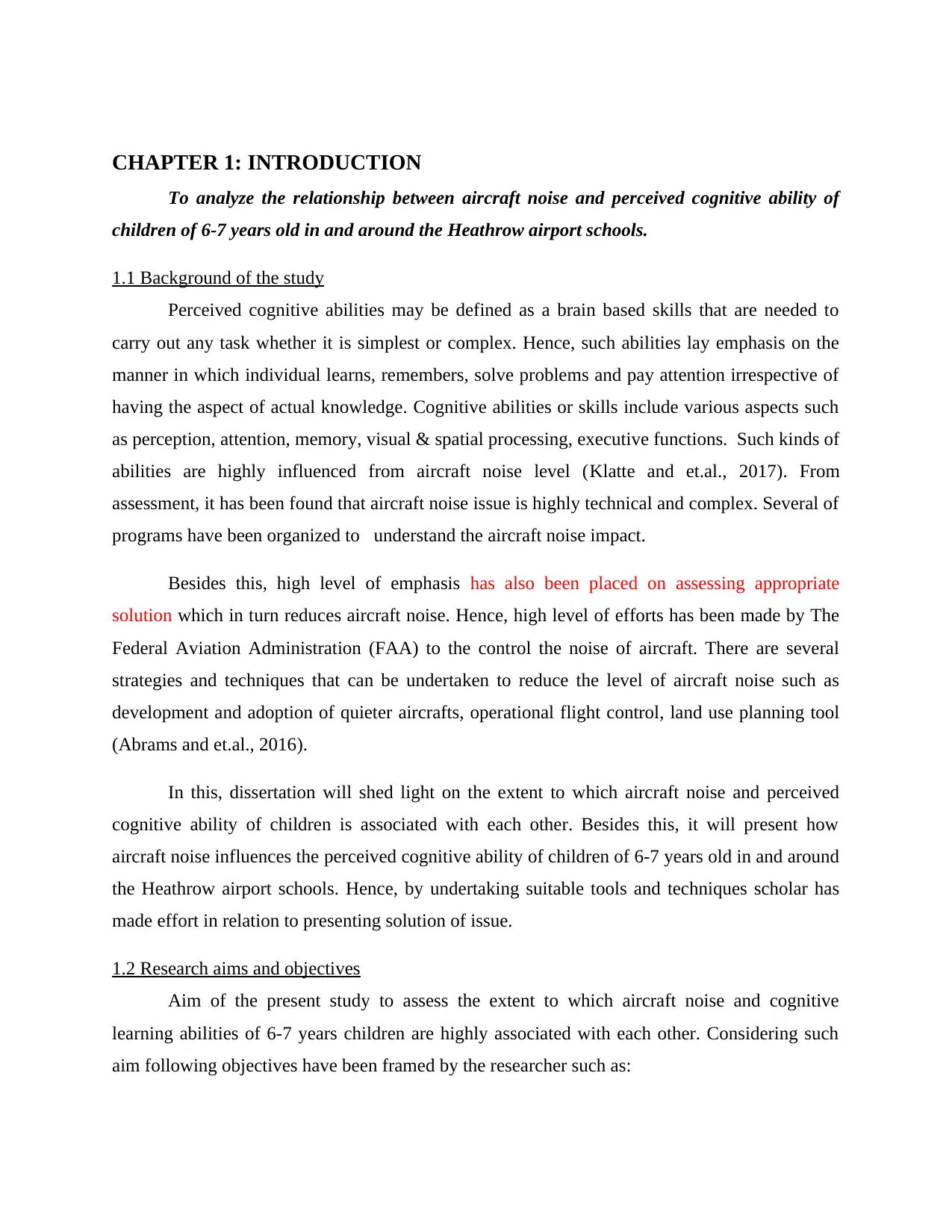
CHAPTER 1: INTRODUCTION
To analyze the relationship between aircraft noise and perceived cognitive ability of
children of 6-7 years old in and around the Heathrow airport schools.
1.1 Background of the study
Perceived cognitive abilities may be defined as a brain based skills that are needed to
carry out any task whether it is simplest or complex. Hence, such abilities lay emphasis on the
manner in which individual learns, remembers, solve problems and pay attention irrespective of
having the aspect of actual knowledge. Cognitive abilities or skills include various aspects such
as perception, attention, memory, visual & spatial processing, executive functions. Such kinds of
abilities are highly influenced from aircraft noise level (Klatte and et.al., 2017). From
assessment, it has been found that aircraft noise issue is highly technical and complex. Several of
programs have been organized to understand the aircraft noise impact.
Besides this, high level of emphasis has also been placed on assessing appropriate
solution which in turn reduces aircraft noise. Hence, high level of efforts has been made by The
Federal Aviation Administration (FAA) to the control the noise of aircraft. There are several
strategies and techniques that can be undertaken to reduce the level of aircraft noise such as
development and adoption of quieter aircrafts, operational flight control, land use planning tool
(Abrams and et.al., 2016).
In this, dissertation will shed light on the extent to which aircraft noise and perceived
cognitive ability of children is associated with each other. Besides this, it will present how
aircraft noise influences the perceived cognitive ability of children of 6-7 years old in and around
the Heathrow airport schools. Hence, by undertaking suitable tools and techniques scholar has
made effort in relation to presenting solution of issue.
1.2 Research aims and objectives
Aim of the present study to assess the extent to which aircraft noise and cognitive
learning abilities of 6-7 years children are highly associated with each other. Considering such
aim following objectives have been framed by the researcher such as:
To analyze the relationship between aircraft noise and perceived cognitive ability of
children of 6-7 years old in and around the Heathrow airport schools.
1.1 Background of the study
Perceived cognitive abilities may be defined as a brain based skills that are needed to
carry out any task whether it is simplest or complex. Hence, such abilities lay emphasis on the
manner in which individual learns, remembers, solve problems and pay attention irrespective of
having the aspect of actual knowledge. Cognitive abilities or skills include various aspects such
as perception, attention, memory, visual & spatial processing, executive functions. Such kinds of
abilities are highly influenced from aircraft noise level (Klatte and et.al., 2017). From
assessment, it has been found that aircraft noise issue is highly technical and complex. Several of
programs have been organized to understand the aircraft noise impact.
Besides this, high level of emphasis has also been placed on assessing appropriate
solution which in turn reduces aircraft noise. Hence, high level of efforts has been made by The
Federal Aviation Administration (FAA) to the control the noise of aircraft. There are several
strategies and techniques that can be undertaken to reduce the level of aircraft noise such as
development and adoption of quieter aircrafts, operational flight control, land use planning tool
(Abrams and et.al., 2016).
In this, dissertation will shed light on the extent to which aircraft noise and perceived
cognitive ability of children is associated with each other. Besides this, it will present how
aircraft noise influences the perceived cognitive ability of children of 6-7 years old in and around
the Heathrow airport schools. Hence, by undertaking suitable tools and techniques scholar has
made effort in relation to presenting solution of issue.
1.2 Research aims and objectives
Aim of the present study to assess the extent to which aircraft noise and cognitive
learning abilities of 6-7 years children are highly associated with each other. Considering such
aim following objectives have been framed by the researcher such as:
⊘ This is a preview!⊘
Do you want full access?
Subscribe today to unlock all pages.

Trusted by 1+ million students worldwide
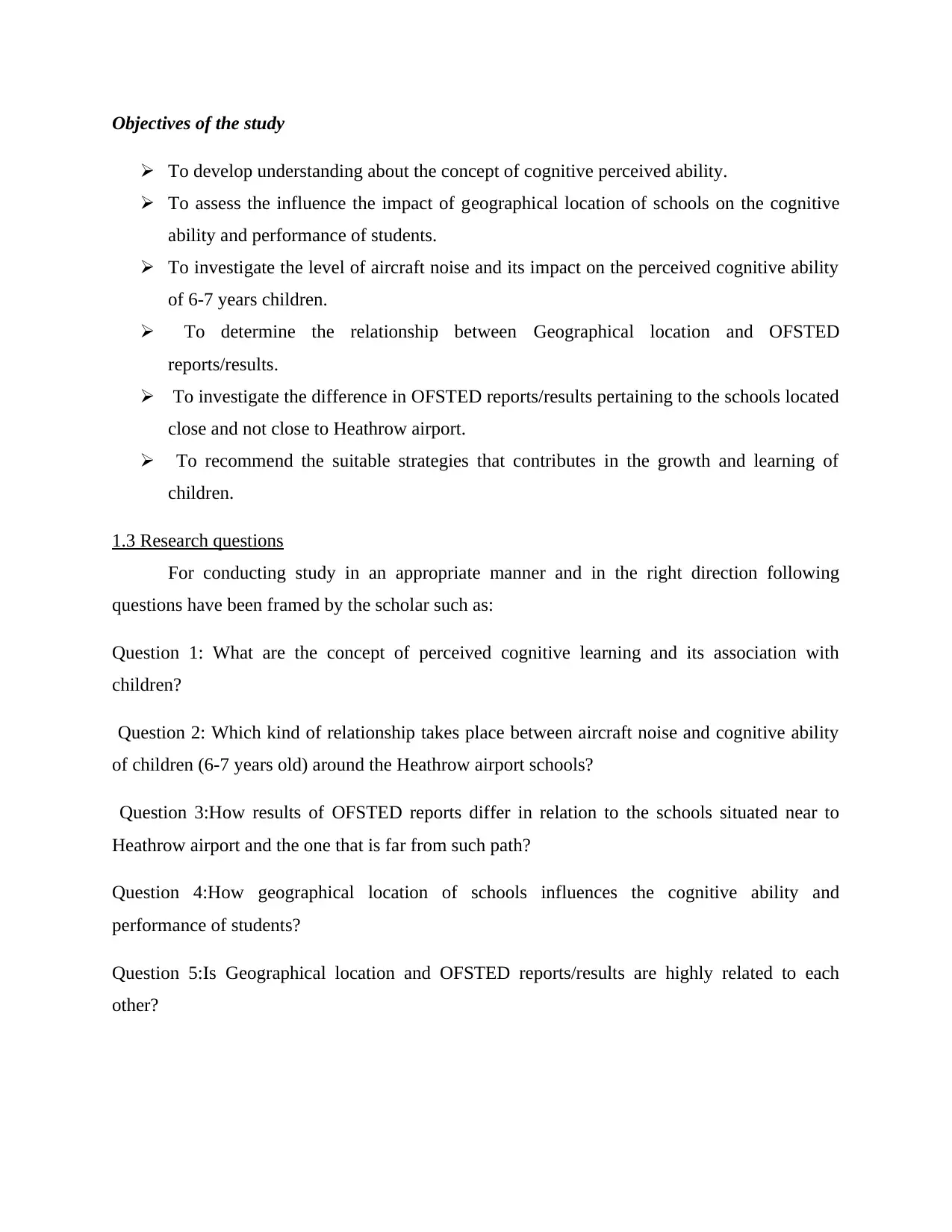
Objectives of the study
To develop understanding about the concept of cognitive perceived ability.
To assess the influence the impact of geographical location of schools on the cognitive
ability and performance of students.
To investigate the level of aircraft noise and its impact on the perceived cognitive ability
of 6-7 years children.
To determine the relationship between Geographical location and OFSTED
reports/results.
To investigate the difference in OFSTED reports/results pertaining to the schools located
close and not close to Heathrow airport.
To recommend the suitable strategies that contributes in the growth and learning of
children.
1.3 Research questions
For conducting study in an appropriate manner and in the right direction following
questions have been framed by the scholar such as:
Question 1: What are the concept of perceived cognitive learning and its association with
children?
Question 2: Which kind of relationship takes place between aircraft noise and cognitive ability
of children (6-7 years old) around the Heathrow airport schools?
Question 3:How results of OFSTED reports differ in relation to the schools situated near to
Heathrow airport and the one that is far from such path?
Question 4:How geographical location of schools influences the cognitive ability and
performance of students?
Question 5:Is Geographical location and OFSTED reports/results are highly related to each
other?
To develop understanding about the concept of cognitive perceived ability.
To assess the influence the impact of geographical location of schools on the cognitive
ability and performance of students.
To investigate the level of aircraft noise and its impact on the perceived cognitive ability
of 6-7 years children.
To determine the relationship between Geographical location and OFSTED
reports/results.
To investigate the difference in OFSTED reports/results pertaining to the schools located
close and not close to Heathrow airport.
To recommend the suitable strategies that contributes in the growth and learning of
children.
1.3 Research questions
For conducting study in an appropriate manner and in the right direction following
questions have been framed by the scholar such as:
Question 1: What are the concept of perceived cognitive learning and its association with
children?
Question 2: Which kind of relationship takes place between aircraft noise and cognitive ability
of children (6-7 years old) around the Heathrow airport schools?
Question 3:How results of OFSTED reports differ in relation to the schools situated near to
Heathrow airport and the one that is far from such path?
Question 4:How geographical location of schools influences the cognitive ability and
performance of students?
Question 5:Is Geographical location and OFSTED reports/results are highly related to each
other?
Paraphrase This Document
Need a fresh take? Get an instant paraphrase of this document with our AI Paraphraser
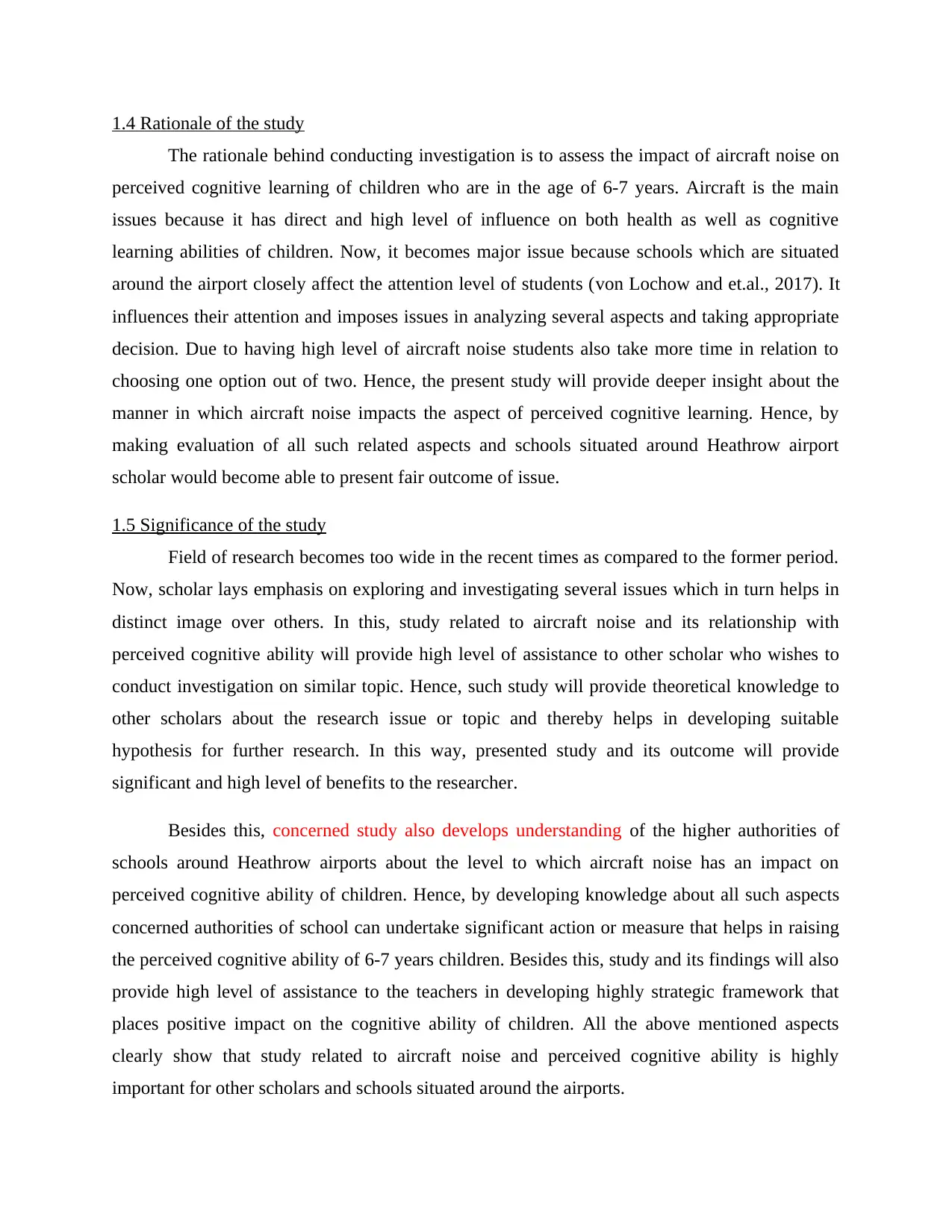
1.4 Rationale of the study
The rationale behind conducting investigation is to assess the impact of aircraft noise on
perceived cognitive learning of children who are in the age of 6-7 years. Aircraft is the main
issues because it has direct and high level of influence on both health as well as cognitive
learning abilities of children. Now, it becomes major issue because schools which are situated
around the airport closely affect the attention level of students (von Lochow and et.al., 2017). It
influences their attention and imposes issues in analyzing several aspects and taking appropriate
decision. Due to having high level of aircraft noise students also take more time in relation to
choosing one option out of two. Hence, the present study will provide deeper insight about the
manner in which aircraft noise impacts the aspect of perceived cognitive learning. Hence, by
making evaluation of all such related aspects and schools situated around Heathrow airport
scholar would become able to present fair outcome of issue.
1.5 Significance of the study
Field of research becomes too wide in the recent times as compared to the former period.
Now, scholar lays emphasis on exploring and investigating several issues which in turn helps in
distinct image over others. In this, study related to aircraft noise and its relationship with
perceived cognitive ability will provide high level of assistance to other scholar who wishes to
conduct investigation on similar topic. Hence, such study will provide theoretical knowledge to
other scholars about the research issue or topic and thereby helps in developing suitable
hypothesis for further research. In this way, presented study and its outcome will provide
significant and high level of benefits to the researcher.
Besides this, concerned study also develops understanding of the higher authorities of
schools around Heathrow airports about the level to which aircraft noise has an impact on
perceived cognitive ability of children. Hence, by developing knowledge about all such aspects
concerned authorities of school can undertake significant action or measure that helps in raising
the perceived cognitive ability of 6-7 years children. Besides this, study and its findings will also
provide high level of assistance to the teachers in developing highly strategic framework that
places positive impact on the cognitive ability of children. All the above mentioned aspects
clearly show that study related to aircraft noise and perceived cognitive ability is highly
important for other scholars and schools situated around the airports.
The rationale behind conducting investigation is to assess the impact of aircraft noise on
perceived cognitive learning of children who are in the age of 6-7 years. Aircraft is the main
issues because it has direct and high level of influence on both health as well as cognitive
learning abilities of children. Now, it becomes major issue because schools which are situated
around the airport closely affect the attention level of students (von Lochow and et.al., 2017). It
influences their attention and imposes issues in analyzing several aspects and taking appropriate
decision. Due to having high level of aircraft noise students also take more time in relation to
choosing one option out of two. Hence, the present study will provide deeper insight about the
manner in which aircraft noise impacts the aspect of perceived cognitive learning. Hence, by
making evaluation of all such related aspects and schools situated around Heathrow airport
scholar would become able to present fair outcome of issue.
1.5 Significance of the study
Field of research becomes too wide in the recent times as compared to the former period.
Now, scholar lays emphasis on exploring and investigating several issues which in turn helps in
distinct image over others. In this, study related to aircraft noise and its relationship with
perceived cognitive ability will provide high level of assistance to other scholar who wishes to
conduct investigation on similar topic. Hence, such study will provide theoretical knowledge to
other scholars about the research issue or topic and thereby helps in developing suitable
hypothesis for further research. In this way, presented study and its outcome will provide
significant and high level of benefits to the researcher.
Besides this, concerned study also develops understanding of the higher authorities of
schools around Heathrow airports about the level to which aircraft noise has an impact on
perceived cognitive ability of children. Hence, by developing knowledge about all such aspects
concerned authorities of school can undertake significant action or measure that helps in raising
the perceived cognitive ability of 6-7 years children. Besides this, study and its findings will also
provide high level of assistance to the teachers in developing highly strategic framework that
places positive impact on the cognitive ability of children. All the above mentioned aspects
clearly show that study related to aircraft noise and perceived cognitive ability is highly
important for other scholars and schools situated around the airports.
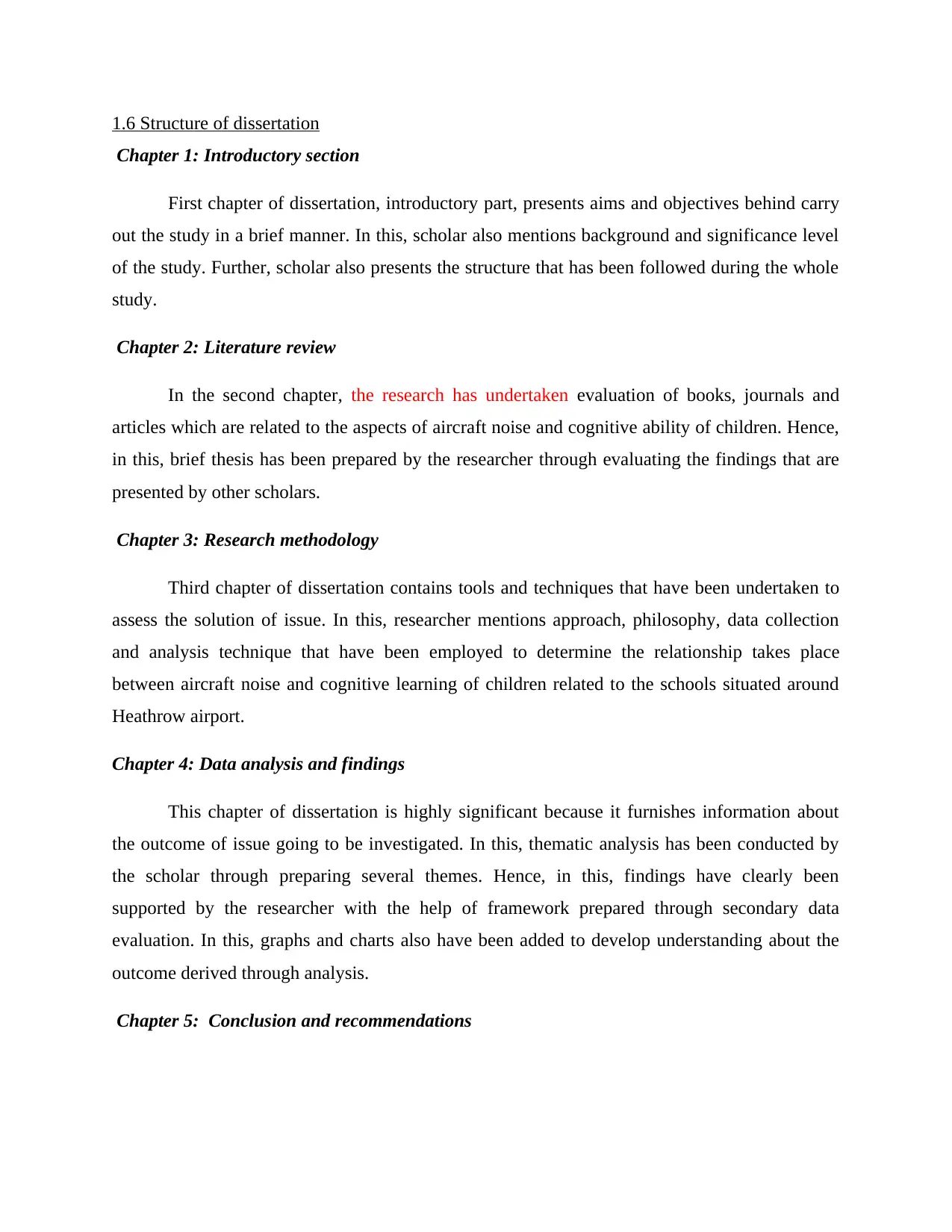
1.6 Structure of dissertation
Chapter 1: Introductory section
First chapter of dissertation, introductory part, presents aims and objectives behind carry
out the study in a brief manner. In this, scholar also mentions background and significance level
of the study. Further, scholar also presents the structure that has been followed during the whole
study.
Chapter 2: Literature review
In the second chapter, the research has undertaken evaluation of books, journals and
articles which are related to the aspects of aircraft noise and cognitive ability of children. Hence,
in this, brief thesis has been prepared by the researcher through evaluating the findings that are
presented by other scholars.
Chapter 3: Research methodology
Third chapter of dissertation contains tools and techniques that have been undertaken to
assess the solution of issue. In this, researcher mentions approach, philosophy, data collection
and analysis technique that have been employed to determine the relationship takes place
between aircraft noise and cognitive learning of children related to the schools situated around
Heathrow airport.
Chapter 4: Data analysis and findings
This chapter of dissertation is highly significant because it furnishes information about
the outcome of issue going to be investigated. In this, thematic analysis has been conducted by
the scholar through preparing several themes. Hence, in this, findings have clearly been
supported by the researcher with the help of framework prepared through secondary data
evaluation. In this, graphs and charts also have been added to develop understanding about the
outcome derived through analysis.
Chapter 5: Conclusion and recommendations
Chapter 1: Introductory section
First chapter of dissertation, introductory part, presents aims and objectives behind carry
out the study in a brief manner. In this, scholar also mentions background and significance level
of the study. Further, scholar also presents the structure that has been followed during the whole
study.
Chapter 2: Literature review
In the second chapter, the research has undertaken evaluation of books, journals and
articles which are related to the aspects of aircraft noise and cognitive ability of children. Hence,
in this, brief thesis has been prepared by the researcher through evaluating the findings that are
presented by other scholars.
Chapter 3: Research methodology
Third chapter of dissertation contains tools and techniques that have been undertaken to
assess the solution of issue. In this, researcher mentions approach, philosophy, data collection
and analysis technique that have been employed to determine the relationship takes place
between aircraft noise and cognitive learning of children related to the schools situated around
Heathrow airport.
Chapter 4: Data analysis and findings
This chapter of dissertation is highly significant because it furnishes information about
the outcome of issue going to be investigated. In this, thematic analysis has been conducted by
the scholar through preparing several themes. Hence, in this, findings have clearly been
supported by the researcher with the help of framework prepared through secondary data
evaluation. In this, graphs and charts also have been added to develop understanding about the
outcome derived through analysis.
Chapter 5: Conclusion and recommendations
⊘ This is a preview!⊘
Do you want full access?
Subscribe today to unlock all pages.

Trusted by 1+ million students worldwide

In the final chapter of dissertation, scholar will conclude all the findings as per the results
derived through primary and secondary data investigation. Besides this, scholar will present the
manner the manner through which perceived cognitive learning can be enhanced.
derived through primary and secondary data investigation. Besides this, scholar will present the
manner the manner through which perceived cognitive learning can be enhanced.
Paraphrase This Document
Need a fresh take? Get an instant paraphrase of this document with our AI Paraphraser
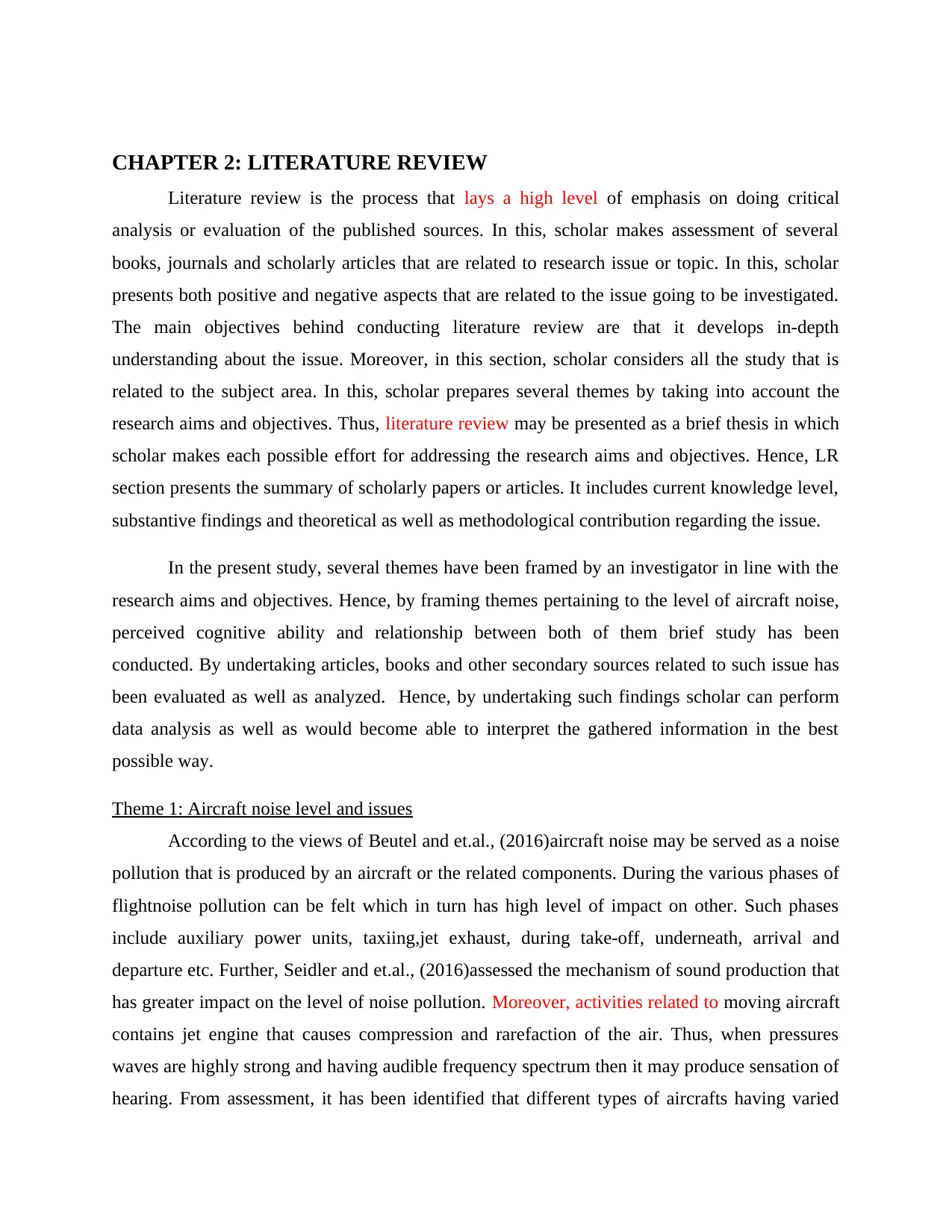
CHAPTER 2: LITERATURE REVIEW
Literature review is the process that lays a high level of emphasis on doing critical
analysis or evaluation of the published sources. In this, scholar makes assessment of several
books, journals and scholarly articles that are related to research issue or topic. In this, scholar
presents both positive and negative aspects that are related to the issue going to be investigated.
The main objectives behind conducting literature review are that it develops in-depth
understanding about the issue. Moreover, in this section, scholar considers all the study that is
related to the subject area. In this, scholar prepares several themes by taking into account the
research aims and objectives. Thus, literature review may be presented as a brief thesis in which
scholar makes each possible effort for addressing the research aims and objectives. Hence, LR
section presents the summary of scholarly papers or articles. It includes current knowledge level,
substantive findings and theoretical as well as methodological contribution regarding the issue.
In the present study, several themes have been framed by an investigator in line with the
research aims and objectives. Hence, by framing themes pertaining to the level of aircraft noise,
perceived cognitive ability and relationship between both of them brief study has been
conducted. By undertaking articles, books and other secondary sources related to such issue has
been evaluated as well as analyzed. Hence, by undertaking such findings scholar can perform
data analysis as well as would become able to interpret the gathered information in the best
possible way.
Theme 1: Aircraft noise level and issues
According to the views of Beutel and et.al., (2016)aircraft noise may be served as a noise
pollution that is produced by an aircraft or the related components. During the various phases of
flightnoise pollution can be felt which in turn has high level of impact on other. Such phases
include auxiliary power units, taxiing,jet exhaust, during take-off, underneath, arrival and
departure etc. Further, Seidler and et.al., (2016)assessed the mechanism of sound production that
has greater impact on the level of noise pollution. Moreover, activities related to moving aircraft
contains jet engine that causes compression and rarefaction of the air. Thus, when pressures
waves are highly strong and having audible frequency spectrum then it may produce sensation of
hearing. From assessment, it has been identified that different types of aircrafts having varied
Literature review is the process that lays a high level of emphasis on doing critical
analysis or evaluation of the published sources. In this, scholar makes assessment of several
books, journals and scholarly articles that are related to research issue or topic. In this, scholar
presents both positive and negative aspects that are related to the issue going to be investigated.
The main objectives behind conducting literature review are that it develops in-depth
understanding about the issue. Moreover, in this section, scholar considers all the study that is
related to the subject area. In this, scholar prepares several themes by taking into account the
research aims and objectives. Thus, literature review may be presented as a brief thesis in which
scholar makes each possible effort for addressing the research aims and objectives. Hence, LR
section presents the summary of scholarly papers or articles. It includes current knowledge level,
substantive findings and theoretical as well as methodological contribution regarding the issue.
In the present study, several themes have been framed by an investigator in line with the
research aims and objectives. Hence, by framing themes pertaining to the level of aircraft noise,
perceived cognitive ability and relationship between both of them brief study has been
conducted. By undertaking articles, books and other secondary sources related to such issue has
been evaluated as well as analyzed. Hence, by undertaking such findings scholar can perform
data analysis as well as would become able to interpret the gathered information in the best
possible way.
Theme 1: Aircraft noise level and issues
According to the views of Beutel and et.al., (2016)aircraft noise may be served as a noise
pollution that is produced by an aircraft or the related components. During the various phases of
flightnoise pollution can be felt which in turn has high level of impact on other. Such phases
include auxiliary power units, taxiing,jet exhaust, during take-off, underneath, arrival and
departure etc. Further, Seidler and et.al., (2016)assessed the mechanism of sound production that
has greater impact on the level of noise pollution. Moreover, activities related to moving aircraft
contains jet engine that causes compression and rarefaction of the air. Thus, when pressures
waves are highly strong and having audible frequency spectrum then it may produce sensation of
hearing. From assessment, it has been identified that different types of aircrafts having varied
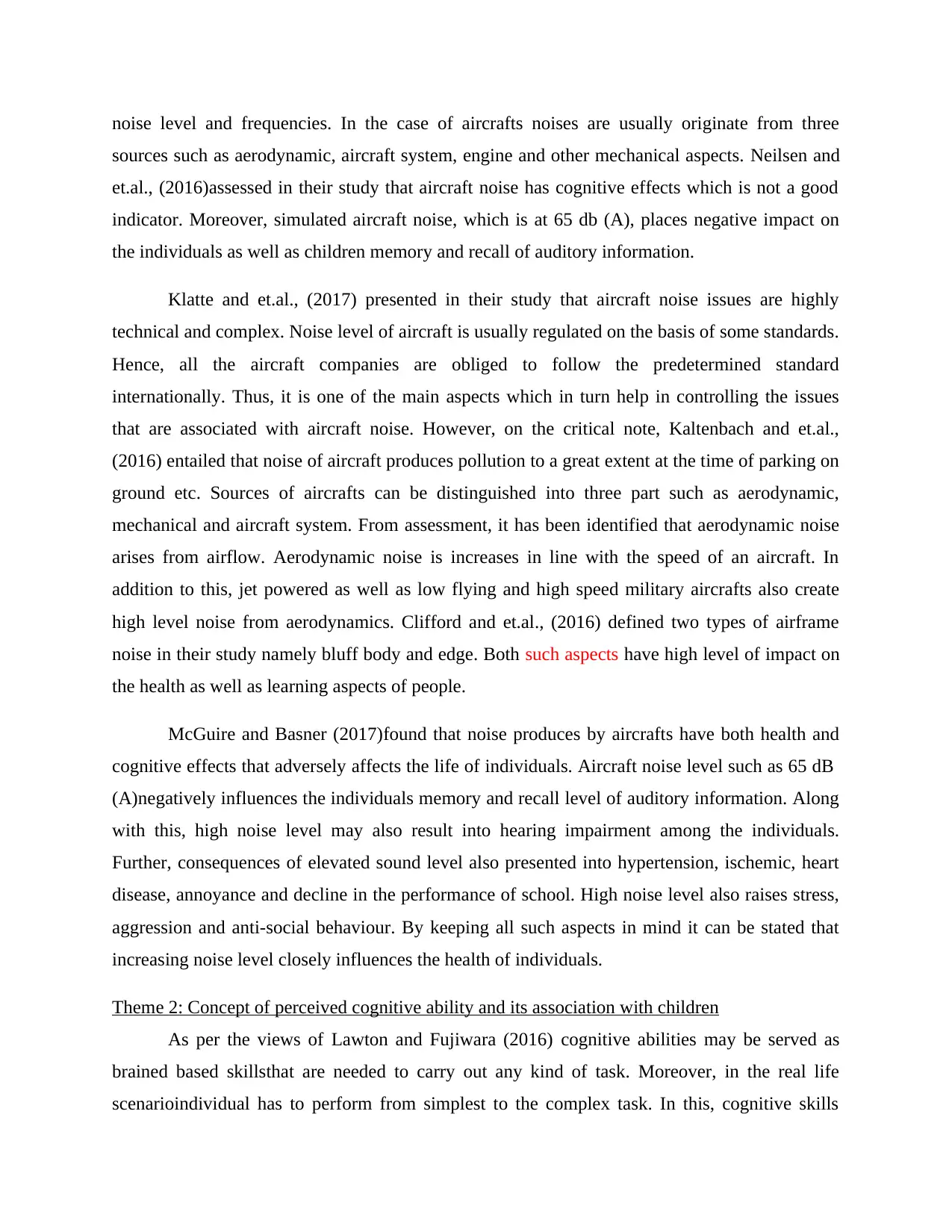
noise level and frequencies. In the case of aircrafts noises are usually originate from three
sources such as aerodynamic, aircraft system, engine and other mechanical aspects. Neilsen and
et.al., (2016)assessed in their study that aircraft noise has cognitive effects which is not a good
indicator. Moreover, simulated aircraft noise, which is at 65 db (A), places negative impact on
the individuals as well as children memory and recall of auditory information.
Klatte and et.al., (2017) presented in their study that aircraft noise issues are highly
technical and complex. Noise level of aircraft is usually regulated on the basis of some standards.
Hence, all the aircraft companies are obliged to follow the predetermined standard
internationally. Thus, it is one of the main aspects which in turn help in controlling the issues
that are associated with aircraft noise. However, on the critical note, Kaltenbach and et.al.,
(2016) entailed that noise of aircraft produces pollution to a great extent at the time of parking on
ground etc. Sources of aircrafts can be distinguished into three part such as aerodynamic,
mechanical and aircraft system. From assessment, it has been identified that aerodynamic noise
arises from airflow. Aerodynamic noise is increases in line with the speed of an aircraft. In
addition to this, jet powered as well as low flying and high speed military aircrafts also create
high level noise from aerodynamics. Clifford and et.al., (2016) defined two types of airframe
noise in their study namely bluff body and edge. Both such aspects have high level of impact on
the health as well as learning aspects of people.
McGuire and Basner (2017)found that noise produces by aircrafts have both health and
cognitive effects that adversely affects the life of individuals. Aircraft noise level such as 65 dB
(A)negatively influences the individuals memory and recall level of auditory information. Along
with this, high noise level may also result into hearing impairment among the individuals.
Further, consequences of elevated sound level also presented into hypertension, ischemic, heart
disease, annoyance and decline in the performance of school. High noise level also raises stress,
aggression and anti-social behaviour. By keeping all such aspects in mind it can be stated that
increasing noise level closely influences the health of individuals.
Theme 2: Concept of perceived cognitive ability and its association with children
As per the views of Lawton and Fujiwara (2016) cognitive abilities may be served as
brained based skillsthat are needed to carry out any kind of task. Moreover, in the real life
scenarioindividual has to perform from simplest to the complex task. In this, cognitive skills
sources such as aerodynamic, aircraft system, engine and other mechanical aspects. Neilsen and
et.al., (2016)assessed in their study that aircraft noise has cognitive effects which is not a good
indicator. Moreover, simulated aircraft noise, which is at 65 db (A), places negative impact on
the individuals as well as children memory and recall of auditory information.
Klatte and et.al., (2017) presented in their study that aircraft noise issues are highly
technical and complex. Noise level of aircraft is usually regulated on the basis of some standards.
Hence, all the aircraft companies are obliged to follow the predetermined standard
internationally. Thus, it is one of the main aspects which in turn help in controlling the issues
that are associated with aircraft noise. However, on the critical note, Kaltenbach and et.al.,
(2016) entailed that noise of aircraft produces pollution to a great extent at the time of parking on
ground etc. Sources of aircrafts can be distinguished into three part such as aerodynamic,
mechanical and aircraft system. From assessment, it has been identified that aerodynamic noise
arises from airflow. Aerodynamic noise is increases in line with the speed of an aircraft. In
addition to this, jet powered as well as low flying and high speed military aircrafts also create
high level noise from aerodynamics. Clifford and et.al., (2016) defined two types of airframe
noise in their study namely bluff body and edge. Both such aspects have high level of impact on
the health as well as learning aspects of people.
McGuire and Basner (2017)found that noise produces by aircrafts have both health and
cognitive effects that adversely affects the life of individuals. Aircraft noise level such as 65 dB
(A)negatively influences the individuals memory and recall level of auditory information. Along
with this, high noise level may also result into hearing impairment among the individuals.
Further, consequences of elevated sound level also presented into hypertension, ischemic, heart
disease, annoyance and decline in the performance of school. High noise level also raises stress,
aggression and anti-social behaviour. By keeping all such aspects in mind it can be stated that
increasing noise level closely influences the health of individuals.
Theme 2: Concept of perceived cognitive ability and its association with children
As per the views of Lawton and Fujiwara (2016) cognitive abilities may be served as
brained based skillsthat are needed to carry out any kind of task. Moreover, in the real life
scenarioindividual has to perform from simplest to the complex task. In this, cognitive skills
⊘ This is a preview!⊘
Do you want full access?
Subscribe today to unlock all pages.

Trusted by 1+ million students worldwide
1 out of 58
Related Documents
Your All-in-One AI-Powered Toolkit for Academic Success.
+13062052269
info@desklib.com
Available 24*7 on WhatsApp / Email
![[object Object]](/_next/static/media/star-bottom.7253800d.svg)
Unlock your academic potential
Copyright © 2020–2025 A2Z Services. All Rights Reserved. Developed and managed by ZUCOL.





